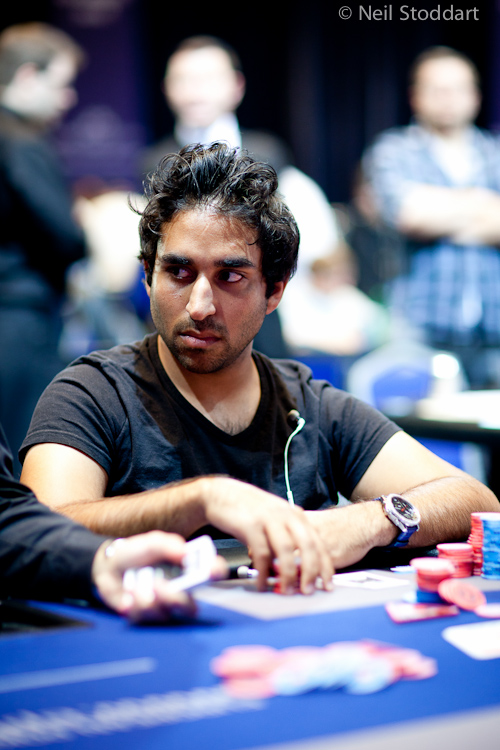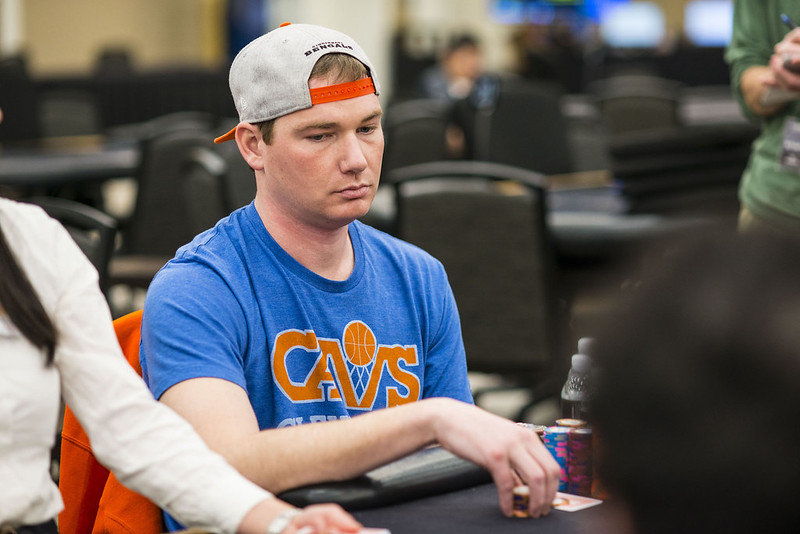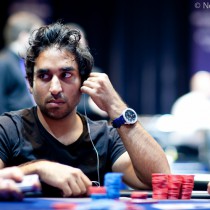With the blinds at 200-300, Vivek Rajkumar (about 25,000) raises to 800, and Amit Makhija (about 15,000) calls. The flop comes 10s8h6s, Makhija checks, Vivek bets 1,200, and Makhija calls. The turn card pairs the board with the 6h, and both players check. Tuesday night marked the end of Day 3 of the World Poker Tour’s Legends of Poker event from the Bicycle Casino in Los Angeles, California. The tournament played down to 27 of poker’s finest. Among them were a handful of PocketFivers, each eyeing the $1.1 million first place prize. Pacing the online poker contingent was. Amit Makhija has won 0 bracelets and 0 rings for total earnings of $958,636. See all events where they placed in-the-money. MOST TRUSTED BRAND IN POKER. Total life earnings: $2,989,538. Latest cash: $2,353 on 05-Jul-2020. Click here to see the details of Amit Makhija's 93 cashes. Amit Makhija enters the final table holding just under 30% of the chips in play, which means that the other five players have a lot of work to do in order to catch up to this young poker prodigy.
Brunson 10 member Amit Makhija, also known as “amak316” online, has been one of the most consistent online and live tournament players for the past three years with winnings exceeding $2.4 million. In every tournament he plays, there are ups and downs, and the best pros have to learn to play optimally with every kind of stack size, even a short one.
That brings us to this week’s subject: Short-stack Tournament Strategy
First, let's talk about being short-stacked with some fold equity. If preflop raises are around 2.5 to 3.5 times the blinds, how many big blinds do you generally need to have to still have fold equity over an open raise?
It depends on the open raiser really. Against players that are really bad and don’t have a good grasp of pot odds, you can definitely justify reshoving as short as 10 times the big blind. In general though, I like to have at least 15 times the big blind against competent players that you feel are opening light. People generally tend to find folds with moderate strength hands when they are getting less than 1.75-1 odds.
If you have enough fold equity, what types of hands do you prefer shoving with against players who you think are opening light and?
If I think their range is severely weighted to weak hands, the cards hardly matter if I can increase my stack by a considerable percentage by shoving. If I think they have a weaker than average range hand, but will still call me a fair percentage of the time, I tend to look for hands like small pairs, good broadway hands, and suited connectors because those types of hands play well enough versus the stronger hands in my opponents range that will call my reshove.
What about tighter open raisers who have a smaller range of raising hands but generally fold to three-bets? Do you need to polarize your range or should you not even shove bad hands against these types of players and just wait for a better spot?

Against weaker players, it’s rarely a mistake to polarize ranges because they aren’t thinking that way in general. They are just trying to put you on a specific hand. If you think their range is tight, but they are calling too tight, you can still consider reshoving light. But, in general, tight players are bad candidates for a resteal. There are definite situations to reshove on tight players that often arise in high buy-in tournaments in which people have satellited into and are playing with scared money. These players can sometimes find a fold with hands that are near the top of their range and can be good targets. Things like balancing ranges are only important against the best regulars that you play on a daily basis because they generally are the only people perceptive enough to realize it.
Are there any other situations you are looking for when you have a 15 big blind stack?
A 15x stack is complicated to play at times. In general, I’m looking to reshove, but often it is a stack that you can profitably open shove. In the state of tournament poker today, everyone is looking to resteal against this stack, so when I have 15 times the big blind and there are a lot of tough regulars at my table, it becomes tough to open hands like small pairs, queen-jack suited, and weak suited aces, even in late position because these aren’t necessarily hands you want to call off your entire tournament life on when you are faced with a resteal. The problem is these hands often figure to be the best hand at the table and folding these hands often makes you play entirely too tight. To combat this, a lot of good players in this situation these days are making larger than average open shoves with as much as 20 times the big blind.
To balance this, you also have to often shove your good hands against perceptive players. This has created an interesting dynamic in high buy-in online tournaments where regular players have been shoving a super wide range of hands. The variance in these tournaments is higher than it ever has been because of this dynamic.
That is an interesting dynamic. Does that maybe mean players are starting to consider themselves short-stacked earlier than in the past because they are able to open shove such a wide range?
People are certainly starting to think they are short-stacked earlier than before. It’s pretty interesting to see how online tournaments have evolved over the years. We are beginning to see this evolution in live tournaments as well, but it will be years before they reach the state that online has because of the speed of online poker, it tends to evolve quickly.

What mistakes do you see players making with this sized stack?
The biggest mistake people make on that stack is opening too much and calling off too tight. A random player will often see hands like seven-eight suited, jack-ten suited, king-jack offsuit, ace-deuce through ace-nine, and other hands that look like they have a lot of value, then will get reshoved on and are forced to fold. They also will often raise hands like king-queen that probably have a lot of equity versus their opponents’ reshoving range, and will still fold to the reshove because they think they can 'find better spots.'
Later this week, Makhija will also discuss playing an even shorter stack of 10 times the big blind, and also demonstrate how these concepts apply to an actual hand. While you're waiting, sign up for an online poker account and work on your game.

Tags
Poker Tournaments

It’s been nearly a decade since Amit Makhija established himself as an emerging force in the poker world, and since then he’s cemented himself as one of the top players in the game. With $2.6 million in live tournament earnings, $3 million in online tournament earnings, and an undisclosed profit in high-stakes cash games, Makhija has managed to achieve longevity in a sport that has a tendency to swallow players up and spit them out.
But it hasn’t always been smooth sailing for the Wisconsin native. There have been times when Makhija wasn’t particularly motivated to put in the required work, and Black Friday had a decidedly negative effect on his player sponsorship opportunities.
Now 30, Makhija has spent the last few years rededicating himself to his progression as a professional poker player and hopes the next decade is chockfull of even more success.
Poker Beginnings
Amit Makhija grew up as the middle child in Brookfield, Wisconsin, a suburb just 15 minutes from Milwaukee.
“My parents moved from India to the U.S. when they were in their 20s,” he explained. “My uncle came to the states first and managed to get a job in Wisconsin, so when my parents came over, they basically followed him to Brookfield.”
His father was an engineer who later became a business owner. His mother is a doctor. Needless to say, education was very important in the Makhija household. After high school, Makhija enrolled in the University of Minnesota, double majoring in finance and economics. It was there that he discovered his passion for poker.
“I started playing poker seriously during my sophomore year of college in 2005,” he recalled. “I had played some $5 home games in high school and stuff before that, but it was mainly an excuse to drink in our basements. I had kind of forgotten about poker, to be honest, but my little brother was really into it. He’s five years younger than me, and one day when I came back to visit from college, he was in the play money games on PokerStars. I thought it looked fun, so I started playing too. Then I found out about all of the freerolls they had on some of the other sites, won one of them, and all of a sudden I had a $100 bankroll.”
That first $100 proved to be the catalyst for Makhija’s entire career, but at the time, it served to fuel his passion for a game that was just beginning to expand into something huge.
Amit Makhija Poker Club
“It was pretty much a standard poker boom story,” he admitted. “I read some strategy books, got better and started building up my bankroll. I never had to make a deposit and I never went broke. By the time I had reached my senior year I was doing really well. During the last week of my finals, I had won over six figures.”
Turning Pro
Makhija had graduated and could have easily entered the traditional working world alongside his parents, but poker was going so well, he thought he’d give it a shot professionally without the constraints of classes and homework.
“My parents were well aware of how much poker I was playing. Every time I came home, I was playing online. When I told them I was going to try and make it in poker, they were obviously concerned, but by that point I had achieved enough success that they could at least see that it wasn’t a completely ridiculous idea. My bankroll was already pretty substantial because I was playing high-stakes online like $25-$50 or $50-$100 no-limit hold’em cash games and $5,000 heads-up sit-n-gos. I had 27 percent rakeback on Full Tilt, and I remember one month that I put in so much volume at the heads-up sit-n-gos that I got back $25,000. I basically had contributed six figures in rake to the site.”
In 2008, Makhija’s first real year on the tournament circuit, he had an absurd string of results. He made four final tables, earned nearly $1 million in live tournaments and finished 21st in the Card Player Player of the Year race. This was highlighted by a fifth-place finish in the $10,000 pot-limit hold’em championship event at the World Series of Poker for $198,528 and a runner-up finish in the WPT Legends of Poker main event for $563,320. To top it all off, he won a major FTOPS (Full Tilt Online Poker Series) title for another $550,000.
“I had an incredible run. I made a few TV final tables and a lot of money. All of a sudden my parents were bragging about me to their friends and they weren’t as concerned about my future. But what that run did actually do was give me a sense of entitlement. In my own head, I had basically solved poker. I had an ego that needed to be knocked down at bit. I remember that year they were doing a fantasy draft and I was picked first overall in a tournament that Phil Ivey was playing in. That’s how good I was running at the time.”
Growing Pains
Makhija’s second year as a pro was solid, but nowhere near the level he achieved in 2008. His third and fourth years were much the same. He was turning a profit, but he knew he wasn’t playing his best.
“The games were good, obviously, but I was a little delusional about how long that would last,” he admitted. “To make things worse, I got lazy and wasn’t playing enough. I was terrible at game selection. When I did play, it was high-stakes heads-up against other great players. I wasn’t learning the other games like the other players were, either. I kind of stuck with hold’em, which made the games even tougher. I didn’t lose money those years, but I didn’t make even close to what I could have if I just had better work ethic and didn’t have that game selection leak.”
Amit Makhija Poker Video
Makhija still had flashes of success. Between 2009 and 2011, he made big final tables and deep runs online and on the European Poker Tour, WSOP and the now-defunct Epic Poker Tour. His online play was so good that he was named as one of the Brunson 10, a group of top players handpicked by Doyle Brunson for his online site, DoylesRoom.com. The deal didn’t last beyond Black Friday, however.
Amit Makhija Poker Rules
“Black Friday was really crappy for me because I had an online poker site deal. The deal was great, because not only did it pay for most of my expenses throughout the year, but we also got to give our input on software changes and stuff like that. We were getting a salary just to put in a minimum of ten hours a month. Then there were changes made in the upper management and we were kind of forgotten about until the deals went away.”
Turning A Corner
Without a deal, Makhija rededicated himself to improving his game. His frustration at how quickly the rest of the poker world was catching up served as his motivation to put in the necessary hours for his development.
“I got really into a lot of the software out there, like Hold’em Resources Calculator and GTO Range Builder,” he said. “I’ve been trying to steer my game towards game theory optimal. The best players are moving closer and closer to it.”
Of course, just because he’s leaning on the numbers more these days doesn’t mean that Makhija is completely giving on playing the player.
“I don’t necessarily want to play like a robot, but I want to know exactly how to play like a robot if I want to against the best players in the world,” he explained. “I want to be able to play in a way that makes it very, very difficult to be exploited. Against weaker players, however, I don’t mind being more flexible in order to get the desired result.”
Since Black Friday, Makhija has had a number of big scores. He went deep in the WSOP main event twice, finishing in 47th in 2012 and 228th in 2013. He also made an additional WSOP final table and finished third in the California State Poker Championship. Most recently, he chopped the Card Player Poker Tour main event at the Bicycle Club Casino and took second in a $25,000 buy-in high roller event at the Aria.
Moving Forward

Makhija has enjoyed his time as a professional poker player, but he does have some mixed feelings about the game.
“There are some negative aspects to life as a poker pro. It’s a very isolating experience. There are people who you are good friends with that you need to beat day in and day out. It seems like people are never fully happy for you either. Your upswing is their downswing and even if they aren’t running that bad, they are depressed because they are not doing quite as well as you. Nobody is ever at the same place, mentally.”
Despite his reservations about his chosen profession, Makhija is still happy with the path he has taken.
“I don’t know that I would recommend being a poker pro to other people,” he admitted. “If my future children came to me asking to learn how to play cards, I would teach them, and then tell them to get a real job. I’d much rather they played poker just as a hobby. But I don’t think I’ll ever look back on the last decade with any regret. It was a lot of fun and I love that I get to compete for a living. I’m living out my dream.” ♠